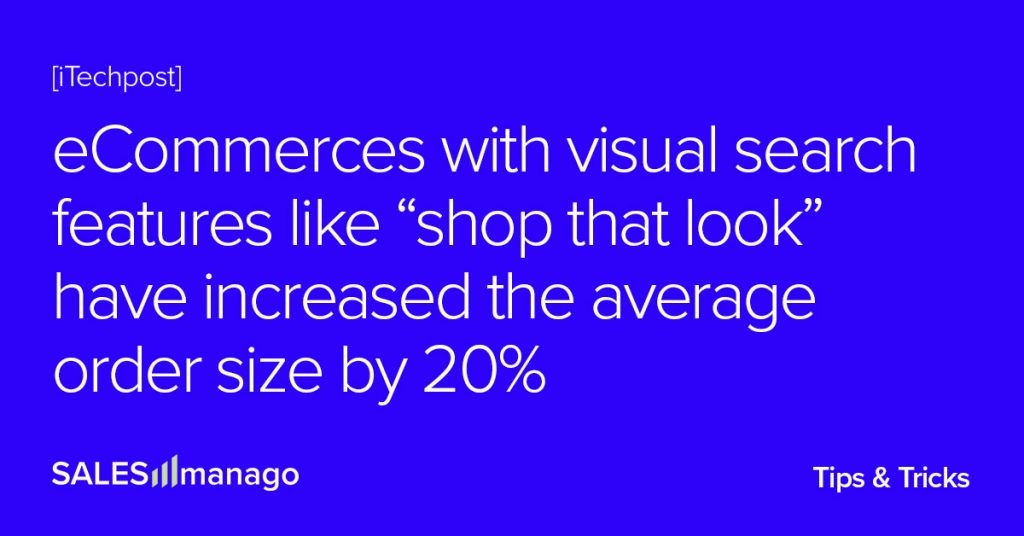
Visual search is taking over eCommerce by storm. Younger audiences prefer to search by photo rather than traditionally type in proper phrases. And even if it might seem like a song of the future, visual search engines are easy to implement. What’s more, with three easy steps they will help you bring CX in your online store to a whole new level. Learn how!
A brief recap: What is Visual Search?
Visual Search is a feature developed recently by many search engine companies. This feature allows your customers (especially those using mobile phones) to upload a picture with a look they like. Then the AI Visual Search Engine will automatically display the products similar or fitting the desired look and feel.
Why is Visual Search important?
Visual search is big. After Google Lens was released, Google revealed that this visual search app had more than 50 million downloads in just 16 months. It works amazingly well in eCommerce as well. Invespcro claims that more than 36% of online shoppers have used visual search and more than half of them finds visual information more useful to them than text information. And revenues of eCommerce websites that are early adopters of visual search are projected to increase their digital commerce revenue by 30%. eCommerces with visual search features like “shop that look” have increased the average order size by 20%. It addresses mostly younger generations. 62% of Millennials want the ability of visual search over any other technology, but just you wait.
There are a few levels of visual search eCommerce proficiency. This feature brings tangible results even on a basic level, but it’s good to know that it can do a tad bit more. In three easy steps you can easily upgrade your visual search from great to outstanding.
Step One: Let people use Visual Search
In its basic version, Visual Search in eCommerce allows customers to search for products similar to the ones they submit as a search query – in the form of an image. The search has two modes. They can either use an image from a camera roll, or take a photo directly from within the visual search engine.
This works amazingly for any store where you buy “with your eyes,” e.g. clothing and shoe stores. Customers can quickly find clothes they like on someone. They can also easily recreate a dream look once found in their social media feed. This basic level of the feature is powerful enough to alter your revenue in a very short period.
There’s one catch. Sometimes AI finds too many item recommendations…
Step Two: Search by photo & filter
Too many options can be overwhelming, especially since AI-powered search results don’t always fully answer the query. It happens because of how algorithms work. Usually they search for distinctive product features in an image and display results based on built-in scoring. This is perfectly normal, but sometimes slightly inconvenient. Fortunately, the search engine can be helped a bit.
Software like Cinderella AI Visual Products Search and Recommendations can be enhanced with additional filtering capabilities. To do this, you need to merge the SALESmanago algorithm with your product feed (no worries, your Marketing Automation Consulting Manager will know how to do that!).
A product feed is an XML file containing metadata of all products in your online store. It’s a good practice to develop it carefully because it helps in many aspects of marketing. Google uses it to display more accurate information in search results. Facebook and Instagram use it to improve your marketing performance and give you new marketing options. SALESmanago CDP uses it to add advanced filtering options to Visual Search. With this combo, products searched based on an image can be further filtered by color, cut, size, material, etc.
Sounds much better, right? But you can push it even further!
Step Three: Push it even further and use Visual Search results as recommendations
There is one more step that will help you milk Visual Search even more. Visual data is still data. SALESmanago can use it to match product recommendations with customer preferences. From now on, you can send emails with recommendations based not only on products browsed in the store, but even send a “Get your dream look!” email and send products that match the customer’s photo.
This is not a standard feature of the system. However, there’s nothing stopping us from tailoring it specifically for you. Ask your Marketing Automation Consulting Manager about the possibility of a dedicated service for recommendations based on Visual Search or contact directly [email protected]



 Follow
Follow
















